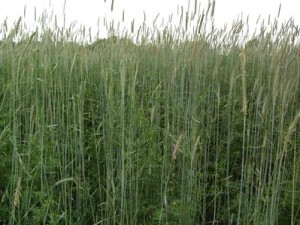FARM AND SOIL MANAGEMENT TO REDUCE CARBON EMISSIONS
FARM AND SOIL MANAGEMENT

TO REDUCE CARBON EMISSIONS
WESTLAND SEED INC.
36272 ROUND BUTTE RD. W., RONAN, MT 59864 (406) 676-4100
FARM AND SOIL MANAGEMENT TO REDUCE CARBON EMISSIONS
We hear about ways to reduce carbon dioxide emissions every day. However, we do not hear enough about how we can capture carbon (carbon sequestration) through proper soil and land management. Healthy soils store carbon—enormous amounts of carbon. Forest soils store the most, followed by grasslands. Soils higher in organic matter hold more carbon.
PRACTICES THAT CAUSE SOILS TO LOSE CARBON:
Tilling breaks down carbon and releases it into the atmosphere, while it exposes soils to drying and erosion, releasing CO2.
Overwatering wastes water and smothers plants and soil microorganisms, causing them to biodegrade without air, releasing methane gas.
Over-application of nitrogenous fertilizers causes increased N2O emissions.
Mono-cropping will exhaust soils.
Summer fallowing allows heating and erosion, which lead to release of CO2.
Stubble-burning destroys organic matter, which causes soil degradation and release of CO2.
WHAT YOU CAN DO TO HELP SOILS CAPTURE AND STORE CARBON:
Reduce tillage as this drastically reduces carbon loss.
Minimize soil erosion to prevent carbon loss. (Erosion can reduce thousands of years of soil carbon storage in minutes.)
Add organic matter to fields by incorporating crop residues, leaving stubble, adding straw, manure and compost when available. Soils high in organic matter store the most carbon.
Irrigate carefully, just enough for crop success avoiding waterlogging soils.
Rotate crops to build soils, reduce insect and disease problems. A rotation including grass is very beneficial to soils’ ability to capture carbon.
Improve grazing lands by aeration, reduction of compaction, and include diverse forage species.
Reforest field boundaries by planting hedgerows and shelterbelts of trees and shrubs. The soils under these plantings will capture and hold the most carbon of any soils.
Manage livestock waste to minimize nitrous oxide and methane emissions. This is less of an issue in open pastures that are not overgrazed.
Soil test regularly especially for pH and P.
DISCUSSION OF CARBON SEQUESTRATION:
The earth’s atmosphere holds about 800 billion tons of carbon at present. Another 560 billion tons of carbon is stored in living plant life. However, the soils of the earth hold much more carbon, about 2,500 billion tons! Forest and grassland soils contain the most carbon, and soils degraded by poor agricultural practices hold the least. Rainforest soils can contain as much as 10% carbon of total mass, while the poorest and highly exploited soils have been reduced to as little as 1% of mass. The process of photosynthesis by plants pulls CO2 out of the air and stores it in living tissues (plant leaves, stems and roots. Excess carbon is released through roots into the soil where it is stored. This process is known as carbon sequestration. Plant roots use living soil fungi (mycorrhizae) in the process. Degraded soils have reduced numbers of these fungi, slowing their ability to sequester carbon.
It is estimated that the world’s agricultural soils have lost 50-70% of their original carbon. Most of that carbon has become CO2 and was released into the earth’s atmosphere. If that carbon could be returned to the earth’s soils, the carbon in the atmosphere could be reduced enough to mitigate global warming and limit heating to below 1.5 degrees Celsius.
HEALTHY SOILS:
Capture large amounts of carbon
Are resistant to erosion
Contain large amounts of organic matter
Are 25% air
Are fertile and have good structure
CROP ROTATION CONCERNS:
A four year (or more) crop rotation plan is best for building soils.
Each successive crop should be of a different plant family. An example is: follow winter wheat (grass family) with a pulse crop (legume family).
Maintain soil cover as much as possible.
Include nitrogen fixing crops in your rotation.
Use cover crops (green manures) whenever possible.
BIBLIOGRAPHY:
Ingram, Dr. Julie, Best Practices for Soil Organic Carbon Management in Agricultural Systems, Countryside & Community Research Institute, UK , 2017
Goode, Cecile M., et. al. Understanding the Impacts of Soil, Climate & Farming Practices on Soil Organic Carbon Sequestration, Australia, 2016
Muchmuller, Megan B., et. al., Emerging Land Use Practices Rapidly Increase Soil Organic Matter, USA, 2015
Zhang, Limimg, et. al, “Toward Optimal Soil Organic Sequestration With Effects of Agriculture Management Practices & Climate Change in Tai-Lake Paddy Soils of China,” In Geoderma, 2016
Smallwood, Mark, Regenerative Organic Agriculture & Climate Change, Rodale Institute, 2013
SRUC, The Scottish Government, Soil Management, Scotland, 2015
